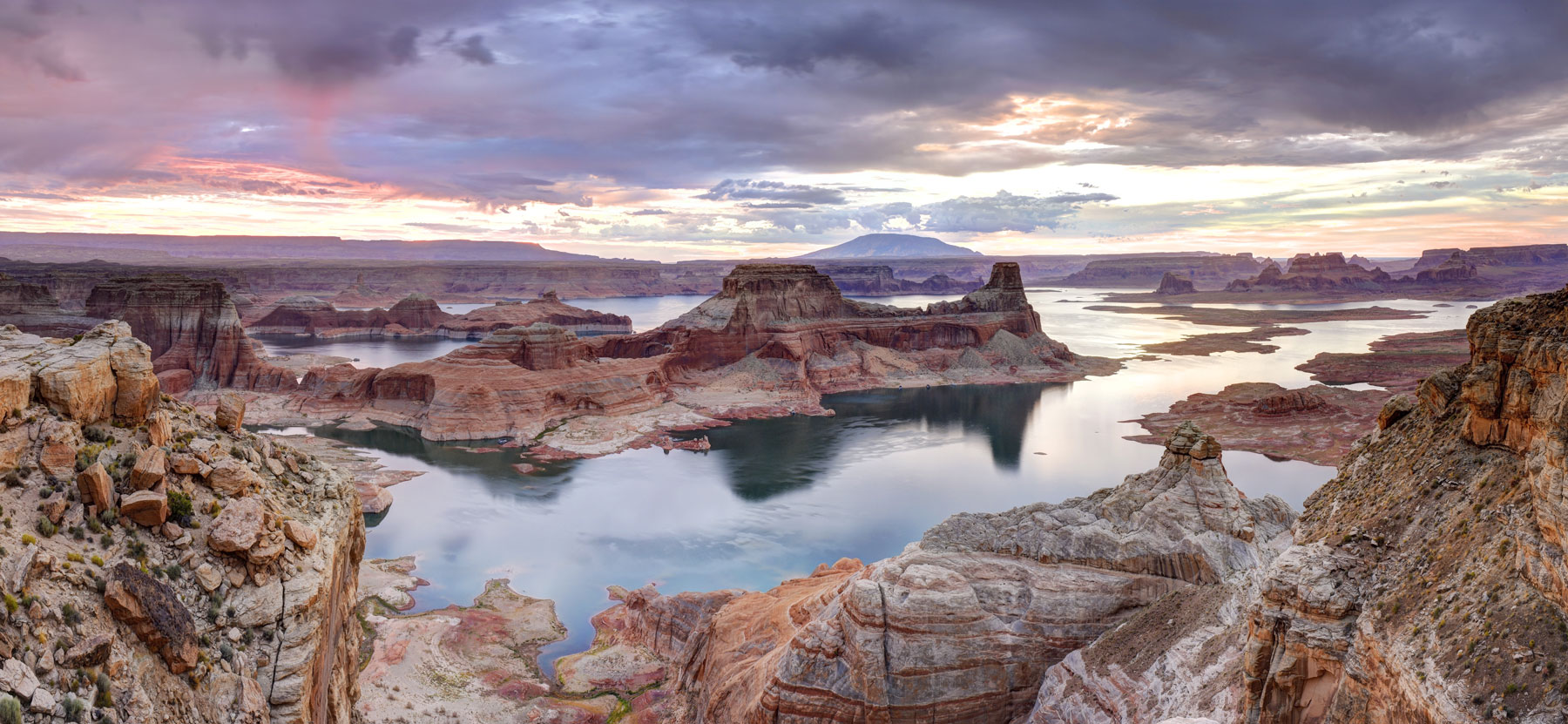What is the Lake Powell Pipeline?
The proposed Lake Powell Pipeline would deliver 86,000 acre-feet of water each year from Lake Powell – a reservoir on the Colorado River – across 140 miles to Washington County, in southwestern Utah. According to the U.S. Bureau of Reclamation, demand for water across the Colorado River Basin – which includes Washington County – began to exceed the Basin’s water supply in 2000. And new pipeline diversions and long-term drought are likely to exacerbate this problem of using more water than the river can provide.
In 2006, the Utah Legislature proposed to build a pipeline to serve Washington and Kane counties at the urging of local leaders who said they feared water shortages would stifle the region’s rapid growth. But the proposal was not driven by a strategic plan. In fact, analysis by WRA and others showed the proposal was based on faulty accounting and an unrealistic estimate of the amount of water needed to meet local demands.
In 2019, the Army Corps of Engineers told the state of Utah it should consider the initial Local Waters Alternative analysis in its planning. Soon thereafter, Utah dropped its application at one federal agency (FERC) and reapplied with another (the Bureau of Reclamation). In early 2020, Kane County pulled out of the proposal, but the Trump administration said it would fast-track Utah’s application through the Bureau of Reclamation.

The Lake Powell Pipeline is Unsustainable, Unnecessary, Expensive, and Contrary to Law
Building a 140-mile pipeline is unsustainable, unnecessary, expensive, and contrary to law compared to designing a well-crafted, multi-pronged plan to meet new water demands. The Local Waters Alternative 2.0 provides a flexible and cost-effective pathway for Washington County to meet water needs through the year 2075. Water conservation is the key component of this alternative. When combined with increased reuse and agricultural water transfers, conservation will result in a more sustainable water supply for generations to come. This is the solution for securing Washington County’s future water needs.
The Lake Powell Pipeline Proposal Relies on Faulty Data and Unrealistic Demand Forecasts
One of the biggest concerns WRA and many others have with the proposal is that the water supply and demand figures that proponents of the pipeline rely upon to justify the need for this pipeline are based on flawed and faulty figures. As the Local Waters Alternative 2.0 report points out, the numerous flaws in data and projections have not been fully addressed. A 2015 audit of the State’s Division of Water Resources by Utah’s Legislative Auditor General revealed numerous problems with the way that water use data are collected and reported by local communities – including Washington County. The primary conclusions of that audit were “The [Utah] Division [of Water Resources] Does Not Have Reliable Local Water Use Data,” and “We [the Division of Water Resources] Question the Reliability of the Division’s Baseline Water Use Study.” The state’s findings corroborate WRA’s conclusion that the water use data in Washington County do not prove a need for this pipeline.
Additionally, in June 2020 draft environmental impact statement (DEIS) prepared by Bureau of Reclamation failed to include the impacts of ongoing water efficiency after 2045 and inflated secondary water demand. It forecasts a remarkably high level of system water loss that is never shown to improve over 50 years. That misleading information in the Lake Powell Pipeline DEIS results in a highly inflated and unrealistic demand forecast for Washington County. Including ongoing efficiency improvements for existing and new customers will cut Washington County’s current and future per capita water demand by almost half, from 286 gallons per capita per day in 2018 to a projected future water demand of 183 gallons per capita per day.
The Lake Powell Pipeline Would Increase Risk for Other Colorado River Water Users
Some state and local leaders argue that the Lake Powell Pipeline would develop Utah’s Colorado River “allocation.” But the reality is that allocations in the Upper Basin states are not fixed in stone, and are declining over time. Collectively, the states tapping into the Colorado River demand more than it can actually provide.
Moreover, current consideration of the pipeline comes at a particularly sensitive time for the Colorado River. The move could potentially impact water rights all across the Colorado River Basin and greatly complicate the multi-state effort to prevent devastating shortfalls in Lake Powell and Lake Mead. Pipeline diversions will make it more likely that hydropower generated by Lake Powell will decrease, and put other water users across the Colorado River Basin at risk. The Colorado River is an overstressed and shared resource, and given the predictions that the river will continue to be over-allocated and stressed by increasingly dry conditions, the Basin states need to manage it thoughtfully and collaboratively to ensure there is enough water for everyone into the future.
WRA’s Solution: The Local Waters Alternative 2.0 Would Ensure a Sustainable Water Supply for Washington County and Save Utah Residents Money
WRA has a long history of advocating for smart water alternatives across the Interior West. The Local Waters Alternative 2.0 is a new report prepared by esteemed engineering firm WaterDM and reviewed by multiple experts in the field of water conservation and efficiency, that compares available local water supply and demand management options in Utah’s Washington County with the proposed Lake Powell Pipeline. The Local Waters Alternative 2.0 builds on initial analysis released in March 2013, which has been revised and updated since. The Local Waters Alternative 2.0 recommends solutions, such as water conservation, water reuse, and agricultural water transfers, for meeting Washington County’s current and future water demand without developing the Lake Powell Pipeline.
The Local Waters Alternative 2.0 has shown that Utah can choose a more sustainable path and save its taxpayers’ money without posing an unnecessary risk to the Colorado River and the millions of people who rely on it for their livelihoods and wellbeing.
The Local Waters Alternative 2.0 is Significantly Less Expensice than the Lake Powell Pipeline
According to an analysis by Western Resource Advocates, the Lake Powell Pipeline as it is currently proposed would require Washington County water users and likely taxpayers all across Utah to foot a very large bill for the pipeline. Current construction costs are estimated to be as much as $1.9 billion.
In contrast, the Local Waters Alternative 2.0 might be implemented for as little as one-fourth of the cost of the pipeline. The estimated conservation costs include water utility administration, rebates, educational programs, and customer expenses associated with purchasing water-efficient appliances or materials. Reuse costs include the construction, operation, and maintenance of a reuse water treatment facility, and water distribution costs. Agricultural water transfer costs reflect the cost to purchase water rights. By investing in these local water supplies, Washington County would maintain the flexibility to pursue additional water supplies in an incremental fashion as new demands arise, which is less financially risky than investing in one single, large pipeline project.
A Combination Of Municipal Conservation, Reuse And Agricultural Water Transfers Can Meet The Water Needs Of Washington County Through 2075
Washington County has one of the highest per capita water use rates in the West – more than double what many other Western cities use. Phoenix, Albuquerque, and Denver residents use less water. A stronger focus on conservation in Washington County for new and existing residents, along with reuse and water transfers, provides an incremental way to meet new demands, instead of diverting more water from the Colorado River in a project that could cost more than $1.9 billion.
Many Western communities with even lower per capita water use rates than Washington County commonly conserve an additional 1% each year. But Washington County’s conservation plans outline a goal to save water at only about half that rate. Based on their data in 2010, water use was estimated to be 241 gallons per capita per day by 2060 (forty years from now). The more recent 2019 Utah’s Regional M&I Water Conservation Goals report sets a goal for Washington County only slightly lower, at 236 gallons per capita per day by 2065. Compare that with desert communities like Tucson, which already is as low as 116 gallons per capita per day, and Albuquerque, which uses 128 gallons per capita per day.
A series of key measures and policies suggested in the Local Waters Alternative 2.0 would drastically reduce water demand in Washington County. Measures include:
- Strong development and landscape codes
- Integration of water efficiency throughout the development process
- Water budget-based rates
- Water loss control
- Adoption of climate-appropriate landscapes
- Incentives for low-flow toilet replacement
- Customer leak detection and monitoring
Additionally, Washington County draws water from the Virgin River. If fully optimized, the Virgin River combined with common-sense conservation measures can provide a more reliable, resilient, and cost-effective long-term supply option than the Lake Powell Pipeline. The Virgin River can provide a future supply of at least 111,000 acre-feet of drinking water and an ongoing 15,600 acre-feet of secondary water, or water that is untreated and used for outdoor residential irrigation. That additional water supply is sufficient to meet anticipated future demands as Washington County continues to grow.

